In this soccer saga, everybody wins
August 15, 2013
His field of dreams had turned into a battlefield.
In March of 2012, residents of northeast San Fernando Valley gathered to oppose plans for two new soccer fields at El Cariso Community Regional Park. It was a sudden and unexpected development during the final stretch of an $11.4 million park-wide renovation project. But James McCarthy didn’t panic. He’d been down this path before as a facilities planner for the Los Angeles County Department of Parks and Recreation.
“When you’re younger, it’s a surprise,” McCarthy said. “When you’ve done this for 25 years, you just hope it doesn’t happen on your project.”
The original plan required the removal of more than 70 eucalyptus trees, which drew the ire of homeowners, the local Chamber of Commerce and other members of the community. They were also concerned about parking, especially on weekends. The critics joined forces, organizing a meeting at Los Angeles Mission College last March. Emotions ran high, and the mood of the meeting quickly turned to anger. Supervisor Zev Yaroslavsky’s office intervened, creating a community advisory group to meet regularly with county representatives to discuss alternatives.
Those sessions weren’t always a walk in the park. But four months later, last July, plans were finally approved by the group to relocate the soccer fields so only two trees would need to be removed.
“There was a lot of heated discussion at that first meeting and subsequent meetings,” said Irene Galvan, a 37-year Sylmar resident and one of the advisory group members who supported the original plan. “County staff listened and made modifications,” she said. “I think people were okay with it after that.”
Opponents of the initial plan, including Benjamin C. Williams, president of the Sylmar Homeowners Association, said they were converted during the inclusive process. He called the final product “perfect.”
“We are in harmony with the plans,” he said, “because we were a part of making them.”
This weekend, a long awaited groundbreaking ceremony for the fields will take place, representing the final gem in the remaking of El Cariso Park. Already completed are a renovation of the park’s swimming pool and a brand new 15,000-square-foot community center and gymnasium. A universal-access park modeled after Shane’s Inspiration in Griffith Park is expected to be completed sometime next spring, giving kids of all ability levels something to shout about.
As far as soccer goes, children from the community are getting a state-of-the-art upgrade from the makeshift dirt field where they now kick the ball around. One field, regulation-sized, will have an artificial playing surface, shaded bleachers and a concession stand. Beside it, a smaller, natural grass field will be built for pick-up games and youth leagues.
There’ll also be plenty of organized activity, said Sandra Chapman, who is responsible for programming at El Cariso Park. She plans to create two official leagues—one for youth and one for adults—along with a youth soccer clinic. Community groups and teams will also be able to reserve the fields, which also can be used for football games. It all adds up to a lot more work for Chapman, who’s hoping for a little help from her friends.
“The community is very connected to us, so where we need volunteers, we got ‘em,” Chapman said.
The fields should be ready for use by late next summer, said Sam Shadab, project manager for the county Department of Public Works. Shadab managed the other park improvements, too, and he said he has no doubt the public will fully embrace the fields when they’re built.
“I have been hearing a lot of praise about the gymnasium—people say it’s the best in the county,” said Shadab. “We are going to continue that tradition of success through this project.”
For McCarthy, who’s been overseeing all this, the fields represent the completion of more than a decade of work. “It’s a great relief,” he said. “Everything is new now. There is just a greater play opportunity across the board.”
Posted 8/15/13
Review ordered of rehab rip-offs
August 14, 2013

An investigative series that revealed corruption in the rehab industry has prompted state and county probes.
Faced with reports of rampant fraud in California’s taxpayer-funded alcohol and drug programs for the poor, the Board of Supervisors on Tuesday ordered an examination of whether “regulatory conflict and confusion” between the state and county may have opened the door to unscrupulous operators.
The board’s action, based on a motion by Supervisor Zev Yaroslavsky, comes in the wake of a year-long investigation by CNN and the Center for Investigative Reporting, which found that during the past two fiscal years in California, $94 million in public funds had been paid to clinics showing “signs of deception or questionable billing.”
Among other things, the “Rehab Racket” series revealed that clinics allegedly submitted bills for fake clients, paid people to sign up for treatment that would be reimbursed by taxpayers and pressured staffers to forge paperwork.
The Drug Medi-Cal program—now the target of a state investigation—is funded through federal and state monies that, in Los Angeles County, are mostly controlled by the Public Health Department’s Substance Abuse Prevention and Control division. The program is jointly administered by the state and county.
During the last fiscal year, L.A. County contracted with 143 providers serving 30,000 clients. Earlier this month, as part of the state’s renewed scrutiny of the Drug Medi-Cal program, funding was cut to nearly 50 agencies statewide that had been suspended from doing business, many of them in Los Angeles County, home to the largest number of these treatment clinics.
Yaroslavsky’s motion aims to sort out the shifting and unclear responsibilities between the state and county that for years have plagued administration and oversight of the program, which is expected to grow as more individuals qualify for Medi-Cal under federal health care reform.
“It is simply unacceptable for a program of such financial magnitude and critical importance to the public’s health to be undermined by bureaucratic confusion and left vulnerable to scammers,” Yaroslavsky said after Tuesday’s board meeting.
To that end, Yaroslavsky’s motion directs the auditor-controller and county counsel to determine, among other things, the county’s legal authority to audit and terminate contracts with Drug Medi-Cal providers, as well provide an analysis of the state’s responsibilities. The board also approved an amendment by Supervisor Mark Ridley-Thomas ordering the public health department and county lawyers to create a plan that helps patients avoid harmful disruptions in their care as the result of recent clinic suspensions.
Posted 8/14/13
Where CBS blackout hits home
August 14, 2013
In the weeks since Time Warner Cable and CBS began feuding, Leadora Sutton has been having technical difficulties in her daily life.
“My main show is ’60 Minutes’ and I miss it terribly,” complains Sutton, 84, whose Westside senior apartment house—like much of Los Angeles—is served by Time Warner. “And I can’t get ‘Family Feud’, which I like to watch at 6 o’clock as I eat dinner. It’s a silly show, but I relax with it. And now it’s gone because we can’t get Channel 9.”
Sutton isn’t the only cable customer who wishes her regularly scheduled programming would resume already. As the ongoing contract dispute between the two media behemoths entered its third week and federal officials fired off letters urging the companies to settle their differences, some 3 million customers this week remained caught in the middle of the argument over their distribution deal.
Lots of folks are annoyed, but nowhere is the aggravation more pronounced than among seniors, who’ve long been the network’s most loyal fans. Their screen-happy kids and grandkids may not miss it so much, what with their binge-watching back episodes of “Breaking Bad” on Netflix, or getting their comedy fix via YouTube on their phones. But for this crowd, losing CBS—with the most mature audience of the four major networks and an average viewer age of almost 57—is like losing an old friend.
“TV is an amazing issue with seniors,” says Doug Cope, director of operations for the Menorah Housing Foundation, which oversees 18 low-income apartment buildings for seniors throughout Los Angeles County, including Sutton’s. “If people start missing their programs,” he says, “you hear from them.”
Since August 2, Time Warner has been blocking out CBS in a standoff over how much the cable giant will pay the network to carry CBS-owned stations in Los Angeles, New York and Dallas. For subscribers here, that has meant not only the absence of popular shows such as “60 Minutes”, “NCIS” and “The Big Bang Theory,” but also the blackout of CBS-owned stations such as Showtime and KCAL Channel 9, which—crucially, in this winning season—airs the Los Angeles Dodgers.
“It’s not a life-or-death thing for the people I’ve heard from,” jokes Robert Miret, manager of the Zev Yaroslavsky Apartments where Sutton lives near Westwood. But, he notes, he is part of another contingent that is increasingly resenting the blackout—sports fans. “So for me . . . “
Miret was among thousands this month who missed the Dodgers game against the St. Louis Cardinals because KCAL was dark on his home television. The blackout continued this week as the Dodgers played the New York Mets—again, only for non-Time Warner viewers. And, Miret notes, football season is about to begin.
For his tenants, however, the irritation has more to do with the interruption of daily habits. Though the complex also offers satellite dish and basic antenna hookups, many of the tenants have chosen the option they’re most used to, which is cable. And, he notes, many can’t switch because the basic antenna hookup is only for high-definition TV, and most of the tenants own older models.
So they’re stuck, he says, and even those who own computers don’t see television the way their grandchildren see it, as just one screen among many. For their generation, and even for many of their children, TV is also a marker of time and a companion. And retirees tend to watch a lot of it.
“Sometimes I’m not out of the house until three or four in the afternoon, now that I’m not working, and as I’m making lunch, I like to watch the shows,” says 67-year-old Sandy Tenenbaum. “I watch ‘The Talk’, which is very interesting. I watch ‘The Doctors’, which is a very informative and educational. I watch ‘Dr. Phil.’ At seven o’clock I watch that ‘Insider’ gossip show with the celebrities.”
Sutton, whose TV now displays Time Warner’s negotiating position when she turns to her favorite channel, says she is making do with other shows while her cable company and her favorite network do battle.
“They’ll fight it out and it’ll be settled in a few weeks,” she predicts. (Meanwhile, CBS has stayed on top of its rivals in the ratings, blackout notwithstanding.)
But without her shows to divert her, Sutton says, she made a call the other day to Time Warner, and came away with an interesting tidbit—confirmed this week by sales representatives at the company’s online support center.
“Did you know,” she asks, “that I can get discounts on my utility bills, my phone bills, even my movie tickets, but my cable company doesn’t give a break to senior citizens?”
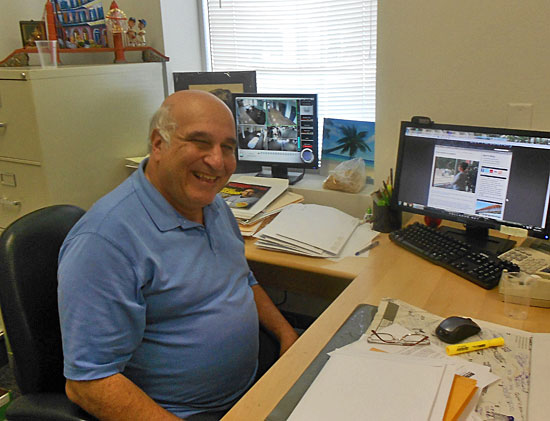
Bob Miret’s fingers are crossed that the blackout will be over in time for football season, in a few weeks.
Posted 8/14/13
Expo shutterbug says so long
August 14, 2013
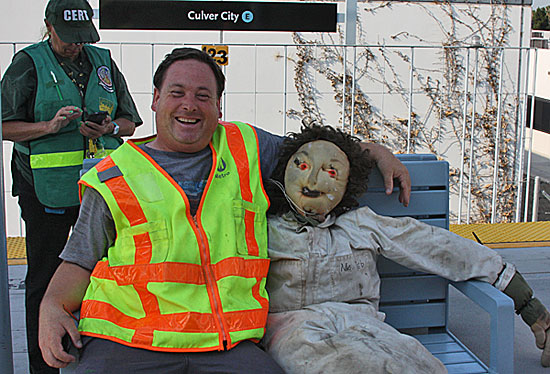
Dwight Sturtevant, aka Expo Line Fan, on the other side of the camera with Metro's crash dummy, Ms. Deb.
By profession, he’s a television engineer. But when he dons a fluorescent yellow vest and picks up his Canon EOS 40D camera, Dwight Sturtevant transforms into…Expo Line Fan.
At least he did until this week.
After nearly three years of chronicling the second, final phase of the Expo Line light rail project down to the last rivet and rebar, Sturtevant is leaving town for a new job in Ohio—and leaving behind a project he has documented in thousands of images and nearly three dozen videos since 2010.
Through it all, Sturtevant has worked anonymously and without compensation, with public credit for his photos going simply to “Expo Line Fan,” if it was given at all. But now, at last, his story can be told.
“I am just a rail fan who has been unofficially the project photographer,” the prolific volunteer said recently as he took a break from packing for the move. “I’ve had a free hand.”
Using his own photo equipment and wearing a Metro safety vest and a hard hat he purchased himself, Sturtevant has become a familiar figure on construction sites all along the 6.6-mile stretch where work is now underway to extend Expo from Culver City to Santa Monica.
His photos have appeared on Metro’s blog The Source, on the project’s website, on Supervisor Yaroslavsky’s website, in construction trade journals and on his own voluminous photo-sharing site.
“We use his pictures even in our office. It’s just built so much enthusiasm,” said Skanska USA Civil Executive Vice President Mike Aparicio, who added that Sturtevant’s outlook on the project has rubbed off on the whole Expo team. “When they see that kind of enthusiasm, they just feed on it.”
“He’s done a great job of capturing key milestones and highlighting progress,” Gabriela Collins, Expo’s government/community relations manager, said in a statement. “We thank him for sharing his wonderful photos and wish him well!”
While others have chronicled Expo’s progress in photographs, “Dwight has taken more than anybody,” and got unique shots because of his access to the construction process, said Darrell Clarke, a founder and co-chair of Friends 4 Expo Transit, longtime advocates for the project. “I’ve enjoyed his passion for following the project,” Clarke said.
Since his photo odyssey began, he has regularly delivered his copious output to the contractor, Skanska USA, to the Expo Construction Authority and to the Metro Library’s archives. It adds up: “If you figure every week since 2010, 200 pictures every week—do the math. It comes out to a lot of pictures.”
His connection to the project began—as so many L.A. adventures do—with a search for an alternate route. He was commuting at the time between downtown Los Angeles and the airport area and started to use Flower Street and Exposition Boulevard to get home. “And that’s when I went, ‘Wow, they’re building a light rail project.’ ”

One of his favorites: time lapse shot of drilling for the Venice Boulevard Bridge. Photo/Dwight Sturtevant for Expo and Metro
When the company he was working for relocated to New Mexico, Sturtevant had more time on his hands and he was able to devote two days a week to photographing Expo.
“Over the last 2½ years, I’ve gotten the respect of Skanska where they’ve allowed me access to the project. Metro’s given me access to do certain things because I’ve earned the trust slowly, proved I wasn’t some nutcase,” he said.
He’s also become a familiar face to Metro’s train operators. For the past two years, he’s been printing up large posters with collages of his photographs to show them the project’s progress. He dropped off his last one at the 7th Street Metro Center last week, with a note: “To all my friends at Metro, I will miss you…I hope you have enjoyed the photos. Dwight S., aka the Expo Line Fan.”
Sturtevant, 51, said he has boyhood memories of looking at freight trains with his grandfather. His rail enthusiasm, literally, came with the territory: “I grew up in Boston. We had the first subway system in the country.”
His wife isn’t so keen on his hobby, however. He said her attitude is best summed up as: “If you’ve seen one train you’ve seen ‘em all.”
But he views his Expo work as a chance to make a difference, and to be an eyewitness to the construction of a light rail project that, in part, moves along the same route once traveled by the city’s late, lamented Red Cars.
“There’s not many places in the country where you’re able to watch cities regain what they’ve lost,” he said. “I mean, L.A. had all this once, and then we lost it.”
Sturtevant said he will be back for the project’s grand opening in 2015, and sooner if he can. In any case, the move to Ohio—where he’ll work for a mobile TV company that records professional sporting events—has at least one advantage for a train buff.
“The house has a big basement,” he said. “I’m going to be able to put my model railroad back up.”

The Venice Boulevard Bridge, under construction last week. Photo/Dwight Sturtevant for Expo and Metro
Posted 8/13/13
The dogs of war come home
August 8, 2013

She was a hero overseas and now Tula, along with handler Dep. Guillermo Loza, is making L.A. County safer.
Just last year, Tula was in Afghanistan, sniffing out buried explosives and saving lives and limbs in the war zone. Now her beat is Los Angeles County, where on a recent afternoon she put her exceptional sniffing abilities to work on a random stroller she encountered in Grand Park.
The glossy black Labrador retriever has traded in her military handler for a new partner on the homefront, Los Angeles County Sheriff’s Deputy Guillermo Loza.
Tula and Loza are part of Countywide Services Division K9, a new sheriff’s unit that started operating last month with a mission of keeping watch over county facilities, parks and events. Tula is an explosives dog, trained to find the various bomb materials that could be used in an attack. She and another black Lab, Ruby, joined the department after serving with the U.S. Marines in Afghanistan. There, Tula and Ruby were experts in locating roadside bombs known as IEDs, or improvised explosive devices. IEDs are the leading cause of fatalities for the U.S. and its allies, responsible for the deaths of 3,275 soldiers in Afghanistan and Iraq as of Memorial Day, 2013.
“They uncovered more than 40 IEDs each,” said Sergeant Mark Jennings, who heads the new division, which also includes his narcotics-sniffing dog, Chip. “They can’t give me a number of lives these dogs saved, but with convoys, it’s in the hundreds.”
Jennings, a former Marine, scored the sought-after hero dogs for Los Angeles County last fall in North Carolina, where representatives from dozens of law enforcement agencies vied for 50 of the returning military canines. The program is part of a campaign to place the dogs as the U.S. reduces its canine military strength in Iraq and Afghanistan from 480 dogs to 180.
As Tula and Ruby went through their paces in front of the law enforcement crowd, Jennings was impressed—and he wasn’t alone.
“Just about everyone wanted Tula and the other half wanted Ruby,” he said. “We had to do a drawing, and we got lucky.”
The 3-year-old Tula and the muscular 6’4” Loza made a striking duo as they made the rounds in Grand Park recently.
“I like your dog,” shouted a young girl while skipping toward the park’s splash fountain.
“Aww, what’s her name?” asked a woman dressed in business attire, while a tourist snapped a photo.
They’re getting used to attention from the public.
“At first they see this tall deputy and they’re like ‘oh my God’ but then they relax and say, ‘Oh look, there’s a dog here,’ ” Loza said.
On cue, Tula darted off and investigated bushes, trash cans, bags and anywhere else a bomb might be hidden. Finding nothing, she returned for a bit of affection and a chance to play with her favorite chew toy.
Like other veterans, Tula and Ruby returned with a few psychological scars.
“Initially they wanted to be very close to you,” Jennings said. “As far as noises and being around people, they were a little hesitant, a little jumpy. They definitely showed signs of what I call PTSD in dogs.”
Handlers of explosive-sniffing dogs need to be the best of the best too, Jennings said. The wrong handler “can screw up a dog very easily.” Loza and Deputy Danny Cassese, who handles Ruby, were at the top of their training class—a prestigious distinction.
Before being deployed, the dogs and deputies trained together with a local expert for four weeks. As they make the transition from military to civilian duty, it helps that they are Labradors, a popular pet breed. The dogs are mellow and gregarious in crowds. German shepherds, on the other hand, tend to intimidate people, Cassese said.
The biggest hurdle was training Tula and Ruby to work on leashes. In Afghanistan, all their searching was performed “off-leash.” Handlers would send them ahead to scout for explosives. On their new beat, much work must be done “on-leash.”
Yet the ability to work off-leash is what sets Tula and Ruby apart from the dogs assigned to the 60 other K9 units in the county, which search for bombs and also things like narcotics, guns and dead bodies. Working off-leash allows the former war dogs to explore suspicious situations while human deputies keep a safe distance.
The dogs live with the deputies and the pairs develop a close bond, which is essential to their performance. Continued training is part of the job description and up to 3 hours of each shift is devoted to it. When the day is done, Tula and Ruby live the good life of any other well-cared-for pet in Southern California. Tula likes running on the beach and investigating every corner of Loza’s house, while the 5-year-old Ruby “will play with a tennis ball until she passes out,” Cassese said.
The deputies receive daily training on trends in terrorism and counter-terrorism efforts, said Loza, who believes domestic attacks like the Boston Marathon bombing could increase as U.S. war efforts draw to a close and create a greater focus on stateside targets. That’s where Tula and Ruby come in.
Last week, the dogs “cleared” (declared safe) a suspicious package at Los Angeles City College. Their biggest find so far came on a parole compliance sweep, which is one of their secondary duties, performed on request. Because guns and ammunition contain gunpowder, the dogs can detect it. Ruby located a belt of 75 high-caliber rifle rounds meant for a machine gun, 50 smaller rifle rounds and a 12-gauge shotgun round that were in the possession of a prior felon. (Loza said both dogs found the bullets, but Ruby got the credit “this time.”)
Jennings said the program is a great financial deal for the county. Bomb-sniffing dogs are bred specifically for the task and undergo months of expert training. All told, each would normally cost upwards of $50,000. As more return from the war, Jennings hopes to expand the division to include up to 5 more K9 teams.
Not all returning war dogs are deemed young enough and fit enough for further service. Some have had serious injuries.
Bob Agnor, a senior trainer for K2 Solutions, a company that provides the dogs and training to the military, said those dogs are returned to civilian life, often being adopted by their Marine handlers.
“These dogs literally saved their lives,” said Agnor, whose company hosted the North Carolina event at which Tula and Ruby were recruited. “They think, ‘This dog has earned the right to live in my house and be treated like a king or a queen.’ ”
Tula and Ruby still wear military dog tags in honor of their service abroad. When they retire from the Sheriff’s Department, Loza and Cassese will have the first option to adopt.
“I’ll get to keep Tula,” said Loza, smiling broadly. “And I will, of course. She’s the best partner ever.”
Posted 8/1/13
Reinventing DCFS
August 8, 2013
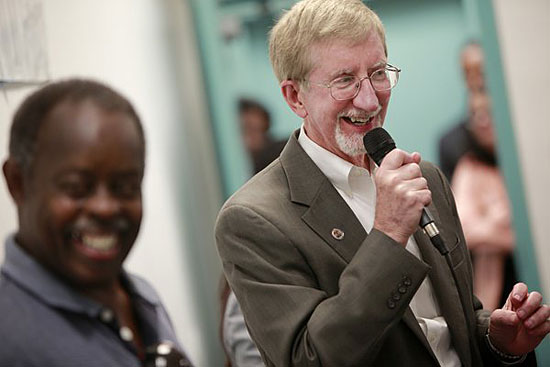
Philip Browning, at a community meeting, is leading the charge to transform DCFS from within. Photo/L.A. Times
Despite the highly-publicized creation of a blue-ribbon commission to investigate potential flaws in Los Angeles County’s child protection system, the Department of Children and Family Services already is in the midst of a sweeping transformation aimed at boosting the beleaguered agency’s effectiveness and accountability.
The breadth of the year-long effort was disclosed publicly for the first time this week by DCFS Director Philip Browning during a presentation before the Board of Supervisors. Appointed less than a year ago by the board, Browning has spearheaded the department’s first strategic plan in a decade—“an adventure,” he calls it—revamping everything from the training and deployment of social workers to the creation of a database identifying children with the greatest levels of instability in their lives.
And, as he did while previously heading the county’s Department of Public Social Services, Browning has brought a statistical sensibility to virtually all facets of DCFS operations, holding managers accountable for achieving quantifiable measures of effectiveness. At the same time, he’s worked closely with, and sometimes bucked, the department’s union to keep more experienced social workers on the front-lines, where they can better protect children in potentially abusive homes.
In recent weeks, concerns have been expressed by some officials, including Supervisor Zev Yaroslavsky, that the board-appointed Blue Ribbon Commission on Child Protection might slow the department’s momentum by making burdensome demands on the agency during the panel’s six-month examination. But the commission’s newly-installed chairman, former DCFS Director David Sanders, insisted in an interview last week that he’s sensitive to the potential for distraction and expects the panel’s work to focus more broadly on the network of agencies entrusted with protecting the county’s children.
In fact, the non-profit Casey Family Programs, where Sanders is now a top executive, is helping DCFS streamline a 6,000-page policy manual that staffers rightly complained was impossible to penetrate, Browning said during his presentation before the board this week, noting that the rewrite was one of numerous “game changers” underway. Among the others:
- Creating a radically different training program for incoming social workers. The curriculum at six local universities that channel social workers to the county is being standardized, revamped and expanded from 8 weeks to 52, with an emphasis on “much more critical thinking and much more real life experience,” Browning said. A key element is being created at USC, where a stage set depicting a roach-infested house in a gang-dominated neighborhood is under construction. Social workers in training will interact with a cast of role-playing adults and children in simulated real life situations, as professors and other students observe the action from behind a one-way mirror.
- Devising an unprecedented data-driven model for customizing social worker caseloads. Previously, caseloads remained largely uniform throughout the department’s 18 field offices. But under Browning’s direction, the agency has created a statistical formula that takes into account the prevalence of certain risk factors among children served by each office. Under the “caseload equity” initiative, social workers in offices with the highest risk scores will be given fewer cases, allowing them to devote more attention to children facing the greatest dangers.
- Preventing emergency response staffers from transferring to new posts after a year. Browning, to the consternation of some of the agency’s unionized social workers, has imposed a freeze on the longtime practice of front-line workers transfering after a single year. These jobs are among the agency’s most demanding and stressful, involving life-and-death decisions about whether to leave children with their families or remove them. Although the union contract allows workers to request such transfers, Browning says he made a “management decision” to block the practice because children were being ill-served by the chronic turnover and brain drain. He’s now pushing for a three-year minimum assignment.
- Developing and implementing a “high risk database” to identify children who need more intensive intervention. Using data mining techniques, the department created an algorithm, believed to be the first of its kind anywhere, that weighted various factors—including how often a child runs away, has a psychiatric hospitalization or moves to different homes—to find those among the 35,000 children in its care who are the most unstable and at risk of aging out of the system into homelessness, joblessness and despair. They are then targeted for an array of tailored treatment services. Browning said 100 high-risk children already have been provided more permanency and stability with a family member, a foster family or a group home.
During his presentation, Browning acknowledged that, while progress has been made, it’s only a start. And he gave the board an example from his world to consider. From their desktop computers, he told the supervisors, “you can see any hotel in the world. You can see what the pool looks like. You can make a reservation.”
But when it comes to using a search engine to find an available home for a foster child, he said, “we can’t do that well in Los Angeles County. We can’t tell if there’s a vacancy for a 2-year-old. That’s something we’ve been working on…and I think we’re going to get there.”
Posted 8/8/13
Summer crimes hit LA’s promenades
August 7, 2013
The news of last weekend’s tragedy on the Venice boardwalk had scarcely broken when Finbar O’Hanlon began fielding the inevitable calls.
“I’m from Australia,” says O’Hanlon, a tech entrepreneur and musician who relocated eight months ago to Venice, “and my friends from overseas were all, ‘Come home! It’s not safe! What are you doing, living there?’ “
Across town, on Hollywood Boulevard, Silvia Figueroa is hearing a similar message. In June, a troubled panhandler stabbed a young woman to death on the Walk of Fame, a few feet from where Figueroa hawks bus tours of homes of the stars. Since then, she says, her mom in Echo Park hasn’t stopped calling—and it didn’t help when a so-called “bash mob” tore down the boulevard in July, randomly robbing people.
“She keeps telling me it’s not safe,” says Figueroa, who, at 23, is the same age as the stabbing victim. “She doesn’t want me to work in Hollywood anymore.”
It’s been an unsettling summer in Los Angeles’ tourist hotspots, with three high-profile violent incidents—the stabbing, the hit-and-run and the “bash mob” robbery spree—in two of L.A.’s most famous promenades.
Not so unsettling that the tourists have stopped coming—visitors from around the world jammed the Walk of Fame this week as usual, interspersed with the inevitable hustlers in Star Wars and Mickey Mouse costumes. And Venice’s beach carnival atmosphere was back within 24 hours after a transient plowed a 2008 Dodge Avenger onto the boardwalk Saturday, veering around traffic barriers to kill a 32-year-old Italian honeymooner and injure 16 others.
But the incidents have been worrisome enough to incite calls this week for improved security measures.
On Tuesday, the Los Angeles City Council voted to augment existing traffic barriers by temporarily blocking more of the nearly 30 streets and alleys on which cars can reach the boardwalk, and to study the possibility of more permanent barriers. Meanwhile, in Hollywood this week, local business representatives plan to present a set of recommendations to Mayor Eric Garcetti aimed at making the Walk of Fame and surrounding area safer.
The list, drawn up by Hollywood’s business improvement districts and Chamber of Commerce, asks, among other things, that the city’s aggressive panhandling ordinance be reviewed and tightened, that sidewalk CD vendors and tour operators be banned from Hollywood Boulevard and that street performers around Hollywood and Highland be required to register with the city, kept to a designated limit and banned from wearing masks.
Los Angeles Police Commander Andrew J. Smith says the demands are understandable, given the crimes’ shocking nature. But, he says, the incidents are anomalies in areas that already have extensive security. The LAPD, he says, has had 20 to 40 extra officers deployed in Hollywood since the June stabbing, “on bikes, cars, foot and horseback”, and deployment is “already robust” in Venice.
“Crime is down across the board in Los Angeles,” Smith notes. “And both Hollywood and Venice are extraordinarily safe, especially compared to the crime rates of ten or 15 years ago. But when something like this happens that gets attention, it gives a false impression.”
That attention worries Stuart Sarbone, 73, a retired businessman who lives so close to the boardwalk that he heard the Venice crash on Saturday from inside his home. Sarbone notes that both the Hollywood stabbing and the hit-and-run down the block from his home appear to have been committed by unstable men.
Nathan Louis Campbell, the 38-year-old Colorado transient arrested after Saturday’s incident, reportedly had a history of substance abuse, and 26-year-old Dustin James Kinnear, charged with killing Christine Calderon on the Walk of Fame, was said to have been in and out of mental health treatment since childhood.
Kinnear has pleaded not guilty to charges of murder. Campbell pleaded not guilty this week to one count of murder, 16 counts of assault with a deadly weapon and 17 counts of hit and run. His lawyer said that he is “profoundly depressed that he has potentially ended someone’s life”, and called the crash “a horrible accident.”
Sarbone says the incidents point to a need for improved mental health care and an examination of L.A.’s safety net.
“There’s a lot of crazy things going on now because people are under terrible, terrible stress,” he says, watching a TV truck set up a camera near a boardwalk shrine to Alice Gruppioni, the Italian woman who died in the Saturday crash. “They have no jobs. They have no money. They get desperate.”
O’Hanlon, the Australian transplant, sees the incident as a tragic-but-rare occurrence, outweighed by Venice’s bohemian excitement. “I could live anywhere in the world,” he says, “and I choose to stay here.”
For many veteran Venetians, however, the incident was a tragic reminder of the vulnerability that comes with living in a community in a tourist destination.
“This isn’t supposed to happen here,” said resident Rachel Shapiro, stopping during her morning walk at the boardwalk shrine with its flowers and candles. “Sixteen million people a year—people from all over the world—come down to this boardwalk. Nobody comes here to die.”
Posted 8/7/13
End of the line for Expo legal challenge
August 7, 2013
A long-running legal challenge to the Exposition Line light rail project, now under construction from Culver City to Santa Monica, was stopped in its tracks this week by the California Supreme Court.
In a 6-1 decision, the court ruled against the group called Neighbors for Smart Rail, which contended in its lawsuit that the environmental reviews for the second and final phase of the Expo project had been inadequate.
The high court said the environmental information considered was sufficient, although they did agree with the plaintiffs on one point: they found that the project should have considered 2015 conditions—not 2030 conditions—in assessing potential impacts. But even so, the justices found, the process “did not deprive the agency or the public of substantial relevant information on those impacts.”
Expo backers hailed the ruling as the last chapter in a lengthy legal battle and said it clears the way for completion of the project, which will provide a transit alternative on a route that for the most part parallels the heavily-congested 10 Freeway.
“With this litigation now behind us, Westside residents can look forward to an exciting new public transit option when the Expo Line is scheduled to open in 2015,” Supervisor Zev Yaroslavsky, a member of the Exposition Light Rail Construction Authority board, said in a statement.
The high court ruling comes after two lower courts also rejected Neighbors for Smart Rail’s arguments. An injunction that would have stopped work on the project while the Supreme Court considered the group’s appeal was turned down in November, 2012.
Construction has been continuing at a brisk pace since then.
“We were free to move forward, and as a result we were able to construct about almost 50% of the project,” said Samantha Bricker, the construction authority’s chief operating officer. “The contractor is moving full steam ahead.”
“I think it’s a win for future riders,” she added, “as the project will be able to be delivered, as it stands right now, on time and on budget.”
Mike Eveloff, a board member of Neighbors for Smart Rail, said the group is continuing to explore its legal options.
“We’re in the weird position of being right on the law but I really think the court was hesitant to stop a big project,” he said. Meanwhile, he added, the organization “stands ready now, as we always have been, to talk about issues outside the legal process” to address its traffic concerns.
The initial phase of the Expo Line, between downtown Los Angeles and Culver City, opened last year to high ridership. When the second, final phase to Santa Monica is complete, Expo will make it possible to travel between downtown L.A. and Colorado Avenue and 4th Street in Santa Monica in 46 minutes.
Posted 8/7/13
Double the star power at the Ford
August 6, 2013

Complexions Contemporary Ballet, above, performs for the first time with Lula Washington Dance Theatre.
Two of the nation’s premier dance troupes team up Saturday at the John Anson Ford Theatre in a groundbreaking collaboration with an East Coast-West Coast spin.
The New York-based Complexions Contemporary Ballet, led by Desmond Richardson and Dwight Rhoden, joins forces with Los Angeles’ own Lula Washington Dance Theatre on the stage of the historic, county-owned amphitheatre.
It marks the first time the companies have performed together. They’ve spent the week collaborating in other ways as well, leading a free audience participation “J.A.M. session” on Tuesday evening and presenting a master class on Thursday for advanced local dance students.
“Both organizations have a desire to innovate and to present dance that removes boundaries,” Adam Davis, the Ford’s managing director, said in a statement.
The Saturday night performance, the second in the newly-inaugurated Zev Yaroslavsky Signature Series, benefits the Ford Theatre Foundation. Benefit tickets range in price from $45 to $85; for availability, please contact the Ford box office at (323) 461-3673.
The program includes Washington’s 2007 “Ode to the ‘60s,” with music ranging from Chuck Berry to the Beatles, and “Rise,” choreographed by Rhoden in 2008 with music by U2. The companies will perform together in the new work “I Wonder Why,” choreographed by Rhoden to vocals by Stevie Wonder. Also featured is the premiere performance of “Turn the Page,” choreographed by Washington. It was inspired in part by Yaroslavsky’s childhood experience turning musical score pages for his great uncle, a string bass player for the Sol Hurok orchestras, in the orchestra pit during ballet performances.
Posted 8/6/13




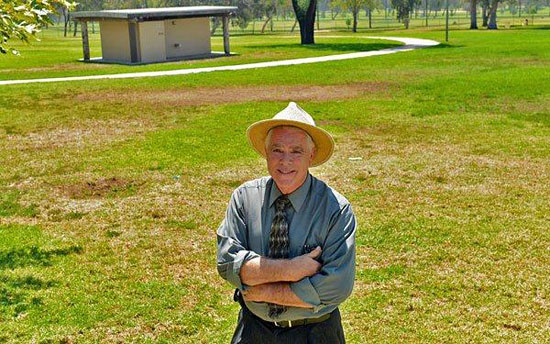
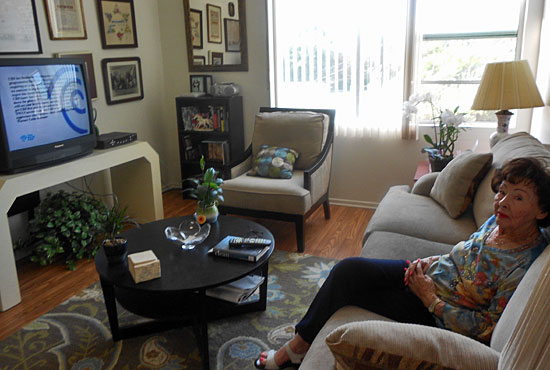

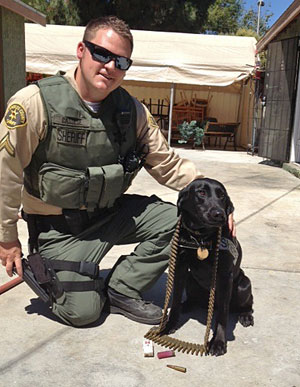

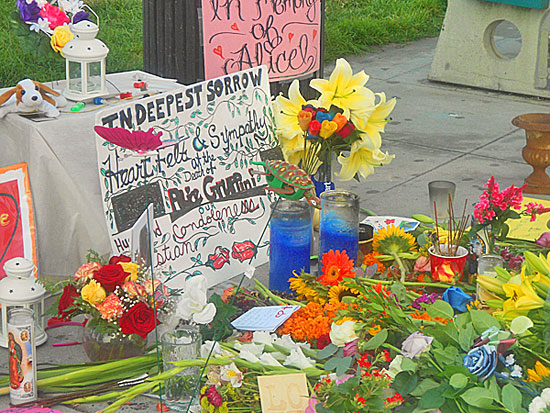
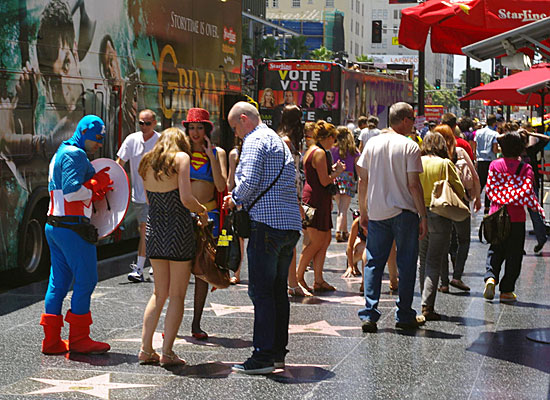







 Check for the latest closure information
Check for the latest closure information








